Assessment of Hydropower Potential in Wastewater Systems and Application in a Lowland Country, Lithuania
Abstract
:1. Introduction
- To review the available best practices of energy recovery in wastewater systems and identify methodology on the basis of local conditions;
- To search for the potential sites for the installation of hydro turbines and to evaluate wastewater resources for harnessing hydropower;
- To review and propose tools to facilitate preliminary and/or feasibility analysis of hydro schemes and to review turbines and their installation layouts in wastewater systems;
- To show best practice in performing multicriteria analysis for the selection of optimal sites.
2. Materials and Methods
2.1. Study Area
2.2. Water Resources
2.3. Assessment Tools
2.4. Multicriteria Analysis (MCA) Methods
3. Results and Discussion
3.1. The Search for Potential Sites
3.2. Wastewater Resources
3.3. Hydromechanical Equipment
3.4. Tools for the Assessment of Technical and Economic Feasibility of Installing In-Conduit Hydropower Systems
3.5. Wastewater Quality and Possible Effects on Turbine Operation
3.6. Multicriteria Analysis for Selecting Potential Sites
4. Conclusions
- While the potential of energy recovery from wastewater systems using micro-hydro plants (MHPs) is an appropriate solution to improve the energy efficiency of the municipal water sector, it has seen no exploitation due to a number of technical and nontechnical issues in low-lying countries. Nontechnical problems include a lack of awareness about the scale of the existing resources available in water networks.
- The potential in lowland areas in terms of power capacity resulting from mostly low-head sites cannot be compared to that of elevated topography. In addition, for flat terrain, the selection field for turbines is relatively narrow; moreover, the low flow rates and small size of turbine units increase the unit price of turbines.
- A methodology was developed to quantify the potential and identify conduit hydropower sites in a lowland country’s wastewater systems, including resource assessment, suitable tools to make a preliminary assessment of potential sites, and choice of turbines and their operating parameters in a harsh environment. The lack of in-depth studies on wastewater quality’s impact on hydro turbines, particularly the risk of clogging them in sewage networks upstream of WWTPs, can be a severe problem.
- A conventional multicriteria analysis can help select the most appropriate site for constructing MHPs in urban water areas to achieve energy recovery. There are plenty of multicriteria tools available on the market for solving any real-world issue. However, at least preliminary site assessments and design procedures must be accessible beforehand for this analysis.
Author Contributions
Funding
Institutional Review Board Statement
Informed Consent Statement
Data Availability Statement
Acknowledgments
Conflicts of Interest
Abbreviation
| WWTP | Waste water treatment plant |
| MHP/SHP/HP | Micro, small hydropower plant or hydropower |
| WSW | Water supply and wastewater distribution network/system |
| CH | In-conduit or hidden hydro |
| FDC | Flow duration curve |
| P | Power, kW |
| Q | Flow, m3/s |
| H | Head, m |
| A | Catchment area, km2 |
| PaT | Pump as turbine |
| MCA | Multicriteria analysis |
References
- Beltran, H.; Vidal, R.; Basiero, L.; Santos, J.M.; Basiero, J.A.; Belenguer, E. Micro hydro installation analysis in a wastewater treatment plant. Renew. Energy Power Qual. J. 2014, 12, 15–20. [Google Scholar] [CrossRef]
- Bousquet, C.; Samora, I.; Manso, P.; Rossi, L.; Heller, P.; Schleiss, A.J. Assessment of hydropower potential in wastewater systems and application to Switzerland. Renew. Energy 2017, 113, 64–73. [Google Scholar] [CrossRef]
- Llácer-Iglesias, R.; Pérez, J.; Satorre-Aznar, J.; López-Jiménez, P.; Pérez-Sánchez, M. Energy recovery in wastewater treatment systems through hydraulic micro-machinery. Case study. J. Appl. Res. Technol. Eng. 2020, 1, 15. [Google Scholar] [CrossRef]
- Diaz-Elsayed, N.; Rezaei, N.; Ndiaye, A.; Zhang, Q. Trends in the environmental and economic sustainability of wastewater-based resource recovery: A review. J. Clean. Prod. 2020, 265, 121598. [Google Scholar] [CrossRef]
- Funding & Tender Opportunities. Available online: https://ec.europa.eu/info/funding-tenders/opportunities/portal/screen/opportunities/topic-details/horizon-cl5-2021-d3-03-11 (accessed on 1 June 2022).
- Choulot, A.; Denis, V.; Punys, P. Integration of Small Hydro Turbines into Existing Water Infrastructures. In Hydropower—Practice and Application; InTech: Rijeka, Croatia, 2012. [Google Scholar]
- Energy Recovery in Water Services. Available online: http://hydro-bpt.bangor.ac.uk/ (accessed on 1 June 2022).
- WP4 Report on Micro Hydropower Resource Assessment in the Atlantic Area. Interreg. Available online: https://www.redawn.eu/sites/default/files/MHP%20Resource%20Assessment%20in%20AA_WP4_TCD_0.pdf (accessed on 1 June 2022).
- European Inventory of Micro-Hydroenergy Recovery Potential in Water Industry. Available online: https://www.lifenexus.eu/en/results/eu-inventory/ (accessed on 1 June 2022).
- Lopez-Fernandez, R.M.; Gonzalez, V.I.S.; Punys, P.; Radzevičius, A.; Steller, J.; Jagielska, A. Web-based Atlas of Micro-hydro Inventory in Urban Water Networks. In Proceedings of the Hydroforum 2019: 9th Polish Hydropower Conference, Gdansk, Poland, 9–10 October 2019. [Google Scholar]
- Sari, M.A.; Badruzzaman, M.; Cherchi, C.; Swindle, M.; Ajami, N.; Jacangelo, J.G. Recent innovations and trends in in-conduit hydropower technologies and their applications in water distribution systems. J. Environ. Manag. 2018, 228, 416–428. [Google Scholar] [CrossRef] [PubMed]
- California Energy Commission. California’s In-Conduit Hydropower Implementation Guidebook: A Compendium of Resources, Best Practices, and Tools: Final Project Report; Stantec Consulting Services Inc.: Edmonton, AB, Canada, 2020.
- Gallagher, J.; Harris, I.M.; Packwood, A.J.; McNabola, A.; Williams, A.P. A strategic assessment of micro-hydropower in the UK and Irish water industry: Identifying technical and economic constraints. Renew. Energy 2015, 81, 808–815. [Google Scholar] [CrossRef]
- Power, C.; McNabola, A.; Coughlan, P. Development of an evaluation method for hydropower energy recovery in wastewater treatment plants: Case studies in Ireland and the UK. Sustain. Energy Technol. Assess. 2014, 7, 166–177. [Google Scholar] [CrossRef]
- Power, C.; Coughlan, P.; McNabola, A. Microhydropower Energy Recovery at Wastewater-Treatment Plants: Turbine Selection and Optimization. J. Energy Eng. 2017, 143, 4016036. [Google Scholar] [CrossRef]
- Munaaim, M.A.C.; Razali, N.; Ayob, A.; Hamidin, N.; Mydin, M.A.O. Potential of Micro Hydroelectric Generator Embedded at 30,000 PE Effluent Discharge of Sewerage Treatment Plant. E3S Web Conf. 2018, 34, 2037. [Google Scholar] [CrossRef]
- García, A.M.; Díaz, J.A.R.; Morillo, J.G.; McNabola, A. Energy Recovery Potential in Industrial and Municipal Wastewater Networks Using Micro-Hydropower in Spain. Water 2021, 13, 691. [Google Scholar] [CrossRef]
- ESHA. Guide on How to Develop a Small Hydropower Plant, 2nd ed.; ESHA: Brussels, Belgium, 2004. [Google Scholar]
- Leyland, B. Small Hydroelectric Engineering Practice; CRC Press, Taylor & Francis Group: Boca Raton, FL, USA, 2014. [Google Scholar]
- Casini, M. Harvesting energy from in-pipe hydro systems at urban and building scale. Int. J. Smart Grid Clean Energy 2015, 4, 316–327. [Google Scholar] [CrossRef] [Green Version]
- Ball, I.; Hendricks, D.; Jawaid, T.S.; Rutz, D.; Steller, J. (Eds.) Small Hydropower Technologies—European State-of-the-Art Innovations. Hyposo; WIP Renewable Energies: Munich, Germany, 2020. [Google Scholar]
- Can New York Supply Water While Generating Clean Energy? Inspiration and Recommendation for Renewable Energy Recovery through Conduit Hydropower. Available online: https://www.hydro.org/wp-content/uploads/2021/09/Grimm-Full-Report-NY-Conduits-1.pdf (accessed on 1 June 2022).
- Ak, M.; Kentel, E.; Kucukali, S. A fuzzy logic tool to evaluate low-head hydropower technologies at the outlet of wastewater treatment plants. Renew. Sustain. Energy Rev. 2017, 68, 727–737. [Google Scholar] [CrossRef]
- Williams, A.A. Pumps as turbines for low cost micro hydro power. Renew. Energy 1996, 9, 1227–1234. [Google Scholar] [CrossRef]
- Steller, J.; Adamkowski, A.; Stankiewicz, Z.; Lojek, A.; Rduch, J.; Zarzycki, M. Pumps as Turbines for Hydraulic Energy Recovery and Small Hydropower Purposes in Poland. In Proceedings of the Hidroenergia 2008, Bled, Slovenia, 12–13 June 2008; p. 10. [Google Scholar]
- de Marchis, M.; Milici, B.; Volpe, R.; Messineo, A. Energy Saving in Water Distribution Network through Pump as Turbine Generators: Economic and Environmental Analysis. Energies 2016, 9, 877. [Google Scholar] [CrossRef] [Green Version]
- Carravetta, A.; Houreh, S.D.; Ramos, H.M. Pumps as Turbines: Fundamentals and Applications; Springer International Publishing: Cham, Switzerland, 2018. [Google Scholar]
- KSB PaT. Pump as Turbine. In Proceedings of the Water Efficiency Conference, Aveiro, Portugal, 5–7 September 2018. [Google Scholar]
- Pumps. Energy Efficient in Forward and Reverse Mode Pumps as Turbines. 2020. Available online: https://www.andritz.com/resource/blob/238812/7e4b07ae7a0061f002e482fc7b12955b/pumps-as-turbines-en-data.pdf (accessed on 1 June 2022).
- Isono, M.; Nohmi, M.; Uchida, H.; Kawai, M.; Kudo, H.; Kawahara, T.; Miyagawa, K.; Saito, S. An experimental study on pump clogging. IOP Conf. Ser. Earth Environ. Sci. 2014, 22, 012009. [Google Scholar] [CrossRef]
- Thamsen, P.U. Cutting clogging in wastewater. World Pumps 2009, 2009, 22–25. [Google Scholar] [CrossRef]
- U.S. Department of Energy. Pumped Storage and Potential Hydropower from Conduits. Report to Congress; U.S. Department of Energy: Washington, DC, USA, 2015.
- ALDEN. In-Conduit Hydropower Project Screening Tool for Water Supply and Wastewater Treatment Facilities. User Manual and Instructions; ALDEN Research Laboratory, Inc.: Holden, MA, USA, 2014. [Google Scholar]
- Voltz, T.J.; Grischek, T. Microturbines at Drinking Water Tanks Fed by Gravity Pipelines: A Method and Excel Tool for Maximizing Annual Energy Generation Based on Historical Tank Outflow Data. Water 2019, 11, 1403. [Google Scholar] [CrossRef] [Green Version]
- Punys, P.; Dumbrauskas, A.; Kvaraciejus, A.; Vyciene, G. Tools for Small Hydropower Plant Resource Planning and Development: A Review of Technology and Applications. Energies 2011, 4, 1258–1277. [Google Scholar] [CrossRef] [Green Version]
- Zhang, Q.F.; Uria-Martinez, R.; Saulsbury, B. Technical and Economic Feasibility Assessment of Small Hydropower Development in the Deschutes River Basin; National Technical Information Service: Fairfax, VA, USA, 2013.
- Natural Resources Canada. Small hydro project analysis chapter. In RETScreen® International. Clean Energy Project Analysis: RETScreen® Engineering & Cases Textbook; Natural Resources Canada: Ottawa, ON, Canada, 2004. [Google Scholar]
- RETScreen. Available online: https://www.nrcan.gc.ca/energy/software-tools/7465 (accessed on 1 June 2022).
- Catrinu-Renström, M.D.; Barton, D.N.; Bakken, T.H.; Marttunen, M.; Mochet, A.M.; May, R.; Hanssen, F. Multi-Criteria Analysis Applied to Environmental Impacts of Hydropower and Water Resources Regulation Projects; SINTEF Energy Research: Trondheim, Norway, 2013. [Google Scholar]
- Williamson, S.J.; Stark, B.H.; Booker, J.D. Low head pico hydro turbine selection using a multi-criteria analysis. Renew. Energy 2014, 61, 43–50. [Google Scholar] [CrossRef]
- Vassoney, E.; Mochet, A.M.; Comoglio, C. Use of multicriteria analysis (MCA) for sustainable hydropower planning and management. J. Environ. Manag. 2017, 196, 48–55. [Google Scholar] [CrossRef]
- Marttunen, M.; Lienert, J.; Belton, V. Structuring problems for Multi-criteria decision analysis in practice: A literature review of method combinations. Eur. J. Oper. Res. 2017, 263, 1–17. [Google Scholar] [CrossRef] [Green Version]
- Roy, B. The outranking approach and the foundations of ELECTRE methods. Theory Decis. 1991, 31, 49–73. [Google Scholar] [CrossRef]
- Figueira, J.R.; Greco, S.; Roy, B.; Słowiński, R. An Overview of ELECTRE Methods and their Recent Extensions. J. Multi-Criteria Decis. Anal. 2013, 20, 61–85. [Google Scholar] [CrossRef]
- Software Related to MCDM. Available online: https://www.mcdmsociety.org/content/software-related-mcdm-0 (accessed on 1 June 2022).
- Zhou, D.; Deng, Z.D. Ultra-low-head hydroelectric technology: A review. Renew. Sustain. Energy Rev. 2017, 78, 23–30. [Google Scholar] [CrossRef]
- Kasiulis, E.; Punys, P.; Kvaraciejus, A.; Dumbrauskas, A.; Jurevičius, L. Small Hydropower in the Baltic States—Current Status and Potential for Future Development. Energies 2020, 13, 6731. [Google Scholar] [CrossRef]
- Radzevičius, A.; Punys, P. In-conduit hydropower possibilities in municipality water networks in a lowland country. In Proceedings of the Polish Hydropower Conference HYDROFORUM 2021, Gdansk, Poland, 13–15 October 2021; IMP PAN: Gdansk, Poland, 2021. [Google Scholar]
- Shaw, E.M.; Beven, K.J.; Chappell, N.A.; Lamb, R. Hydrology in Practice, 4th ed.; CRC Press, Taylor & Francis Group: New York, NY, USA, 2010. [Google Scholar]
- Poška, A.; Punys, P. Inžinerinė Hidrologija (Engineering Hydrology, in Lith.); LŽŪU leidybinis centras: Kaunas, Lithuania, 1996; p. 539. [Google Scholar]
- Mazzetto, F.; Papetti, L.; Pelikan, B. Small Hydroelectric Plants. Guide to the Environmental Approach and Impact Assessment; Studio Frosio, European Commission (DGTREN, FP5, ENERGIE): Brescia, Italy, 2000; p. 110. [Google Scholar]
- Figueira, J.; Greco, S.; Ehrogott, M. Multiple Criteria Decision Analysis. State of the Art Surveys; Greco, S., Ehrgott, M., Figueira, J.R., Eds.; Springer: New York, NY, USA, 2016. [Google Scholar]
- Bekker, A.; van Dijk, M.; Niebuhr, C.M.; Bhagwan, J.N. Development of a tool to identify hydropower potential at pressure reducing stations in South African water distribution systems. In Proceedings of the HYDRO 2020, Online, 26–28 October 2020. [Google Scholar]
- United States Geological Survey. EarthExplorer. Available online: https://earthexplorer.usgs.gov/ (accessed on 1 June 2022).
- Uuemaa, E.; Ahi, S.; Montibeller, B.; Muru, M.; Kmoch, A. Vertical Accuracy of Freely Available Global Digital Elevation Models (ASTER, AW3D30, MERIT, TanDEM-X, SRTM, and NASADEM). Remote Sens. 2020, 12, 3482. [Google Scholar] [CrossRef]
- Mitrovic, D.; Díaz, J.A.R.; Morillo, J.G.; Coughlan, P.; Gallagher, J.; McNabola, A. Hydropower energy recovery in water pipe networks: Spatial regression analysis using GIS, assessing the correlation between energy recovery potential and geographical data. In Proceedings of the Water Efficiency Conference, Aveiro, Portugal, 5–7 September 2018; pp. 127–136. [Google Scholar]
- Tian, Y.; Zhang, F.; Yuan, Z.; Che, Z.; Zafetti, N. Assessment power generation potential of small hydropower plants using GIS software. Energy Rep. 2020, 6, 1393–1404. [Google Scholar] [CrossRef]
- Bureau of Reclamation. Hydropower Resource Assessment at Existing Reclamation Facilities; Bureau of Reclamation: Washington, DC, USA, 2011.
- Hydroelectric Design Center. Hydropower Resource Assessment at Non-Powered Usace Sites; Hydroelectric Design Center: Nashville, TN, USA, 2013. [Google Scholar]
- Lashofer, A.; Hawle, W.; Pelikan, B. Innovative Approaches to Global Challenges. In State of Technology and Design Guidelines for the Archimedes Screw Turbine, Proceedings of the Conference HYDRO 2012, Bilbao, Spain, 29–31 October 2012; Aqua-Media International Ltd.: London, UK, 2012. [Google Scholar]
- YoosefDoost, A.; Lubitz, W.D. Archimedes Screw Turbines: A Sustainable Development Solution for Green and Renewable Energy Generation—A Review of Potential and Design Procedures. Sustainability 2020, 12, 7352. [Google Scholar] [CrossRef]
- The Amjet Turbine Systems. ATS-63 Low Head Hydro Turbine/Generator. White Paper. 2015. Available online: http://amjethydro.com/downloads/Whitepaper4-2-15.pdf (accessed on 1 June 2022).
- Gruber, R. The VOITH StreamDiver: Versatile, environmentally friendly, robust and affordable solutions for the low-head segment. Zek Hydro 2021, 25–29. Available online: https://issuu.com/zekmagazin/docs/zek_international_2021 (accessed on 1 June 2022).
- Low Head Hydroelectric Turbines. Available online: https://www.turbiwatt.com/en/choisir-sa-turbine-2.html (accessed on 1 June 2022).
- HYDROMATRIX: Innovative Hydropower Solutions. Fact Sheet. 2014. Available online: https://www.andritz.com/resource/blob/31692/f484084e0869b431e2362b1e82bef5b2/hy-hydromatrix-en-data.pdf (accessed on 1 June 2022).
- Flygt Submersible Turbines. Available online: https://www.xylem.com/en-us/products--services/hydro-turbines2/hydro-turbines/ (accessed on 1 June 2022).
- Tracey, L.; Paul, C.; Aonghus, M. Pump-As-Turbine: Characterization as an Energy Recovery Device for the Water Distribution Network. J. Hydraul. Eng. 2017, 143, 04017020. [Google Scholar] [CrossRef]
- Novara, D.; Carravetta, A.; McNabola, A.; Ramos, H.M. Cost Model for Pumps as Turbines in Run-of-River and In-Pipe Microhydropower Applications. J. Water Resour. Plan. Manag. 2019, 145, 04019012. [Google Scholar] [CrossRef]
- Qasim, S.R. Wastewater Treatment Plants: Planning, Design, and Operation, 2nd ed.; Routledge: Oxford, UK, 2017. [Google Scholar]
- Anyi, M.; Kirke, B. Evaluation of small axial flow hydrokinetic turbines for remote communities. Energy Sustain. Dev. 2010, 14, 110–116. [Google Scholar] [CrossRef]
- Nishi, Y.; Kobori, T.; Kobayashi, Y.; Inagaki, T.; Kikuchi, N. Study on Foreign Body Passage in an Ultra-Small Axial Flow Hydraulic Turbine. Int. J. Fluid Mach. Syst. 2020, 13, 68–78. [Google Scholar] [CrossRef]
- Sewage Handling Data (Nuotekų Tvarkymo Apskaitos Duomenys). Available online: https://vanduo.old.gamta.lt/cms/index?rubricId=6c0feeaa-4d89-4a23-9339-19ab0de0adf1 (accessed on 1 June 2022).
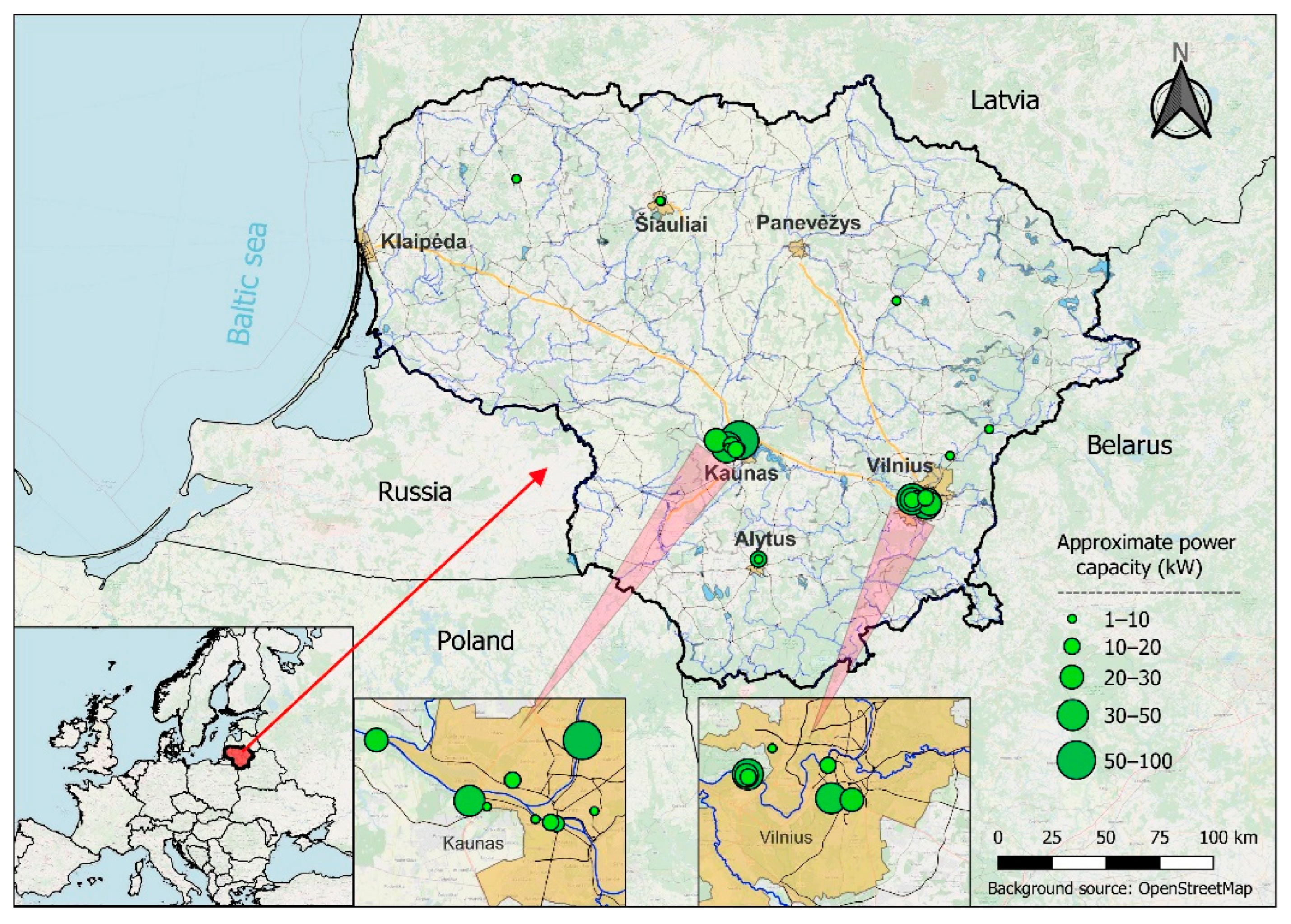
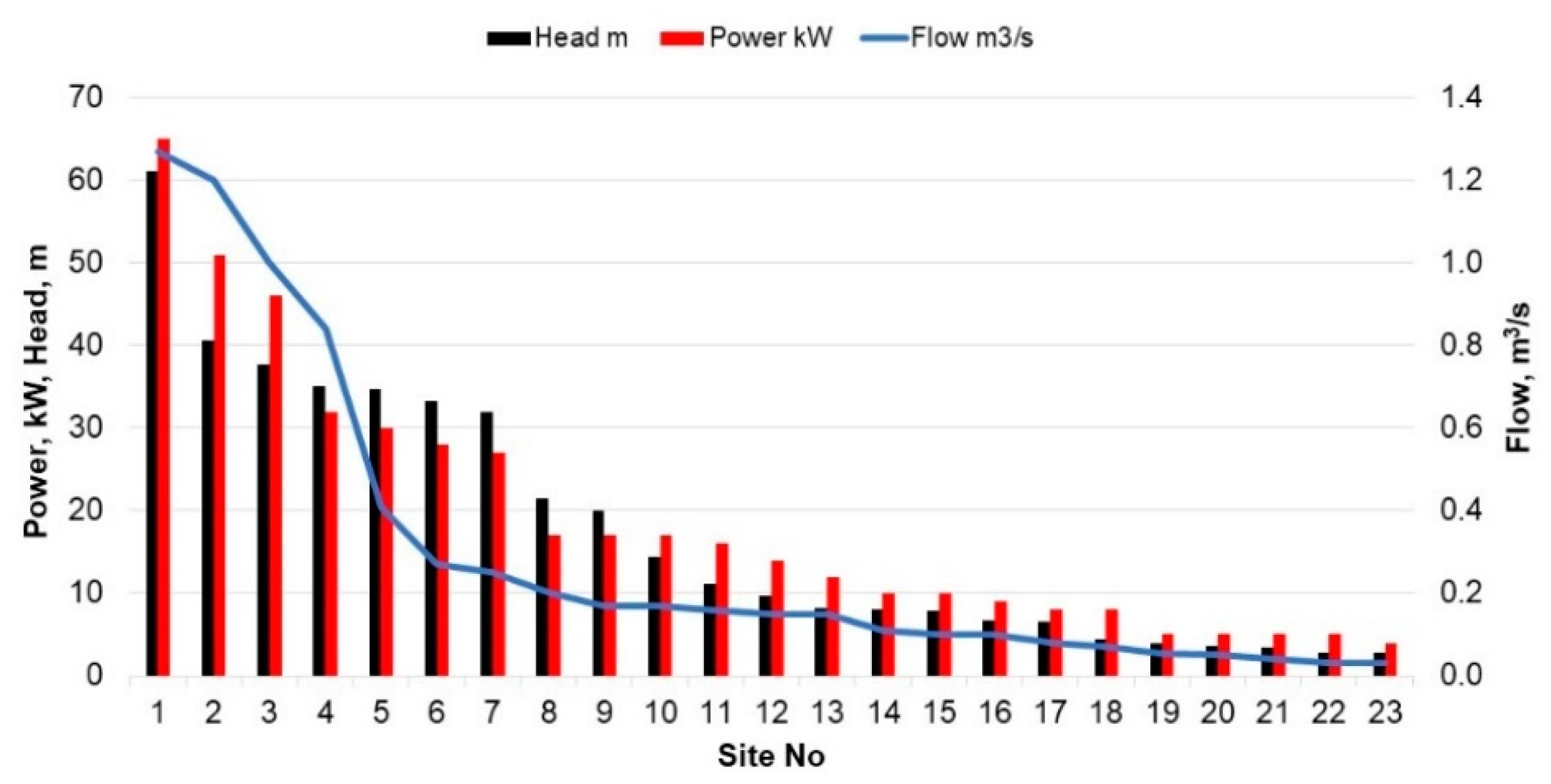

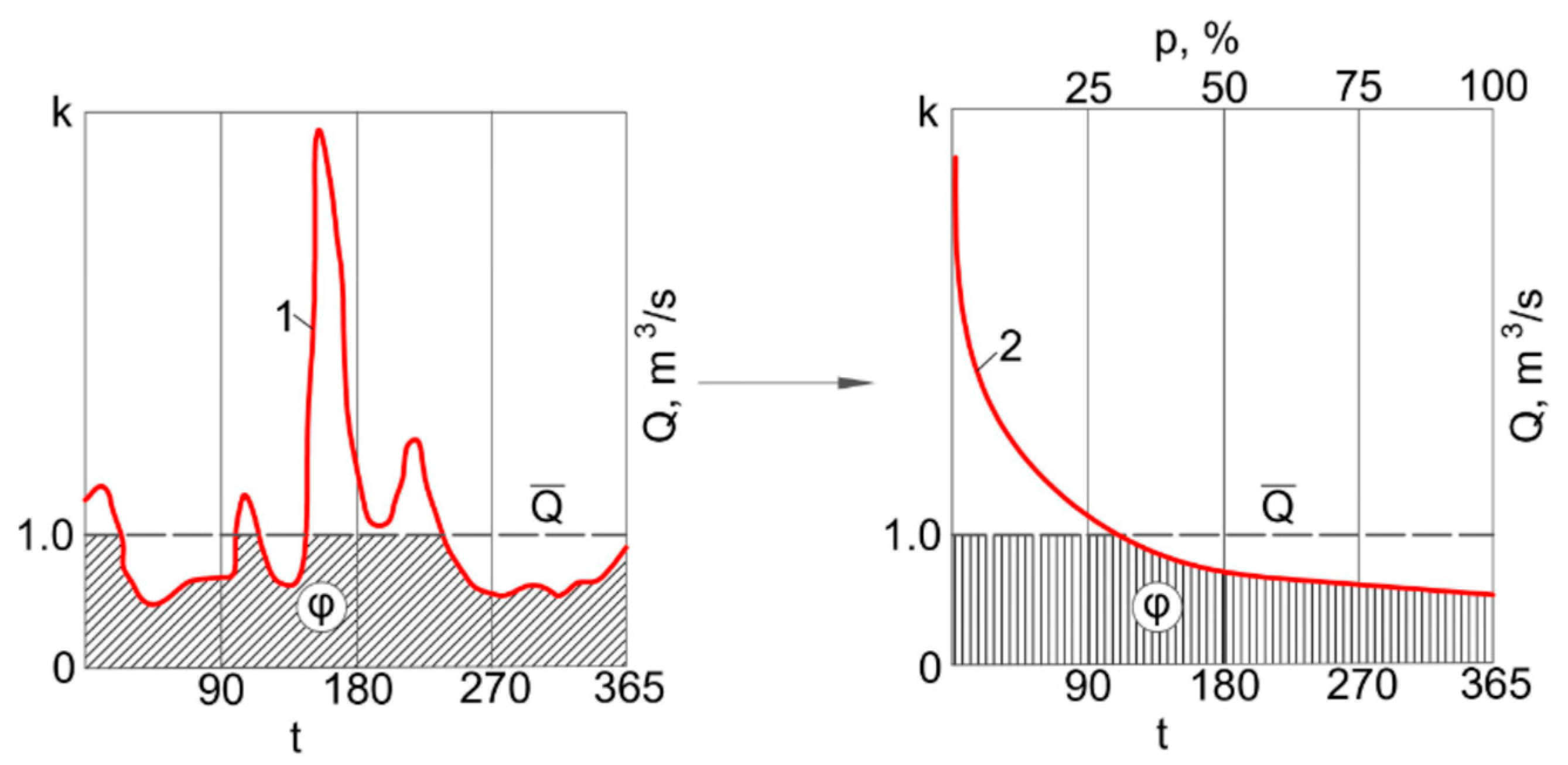

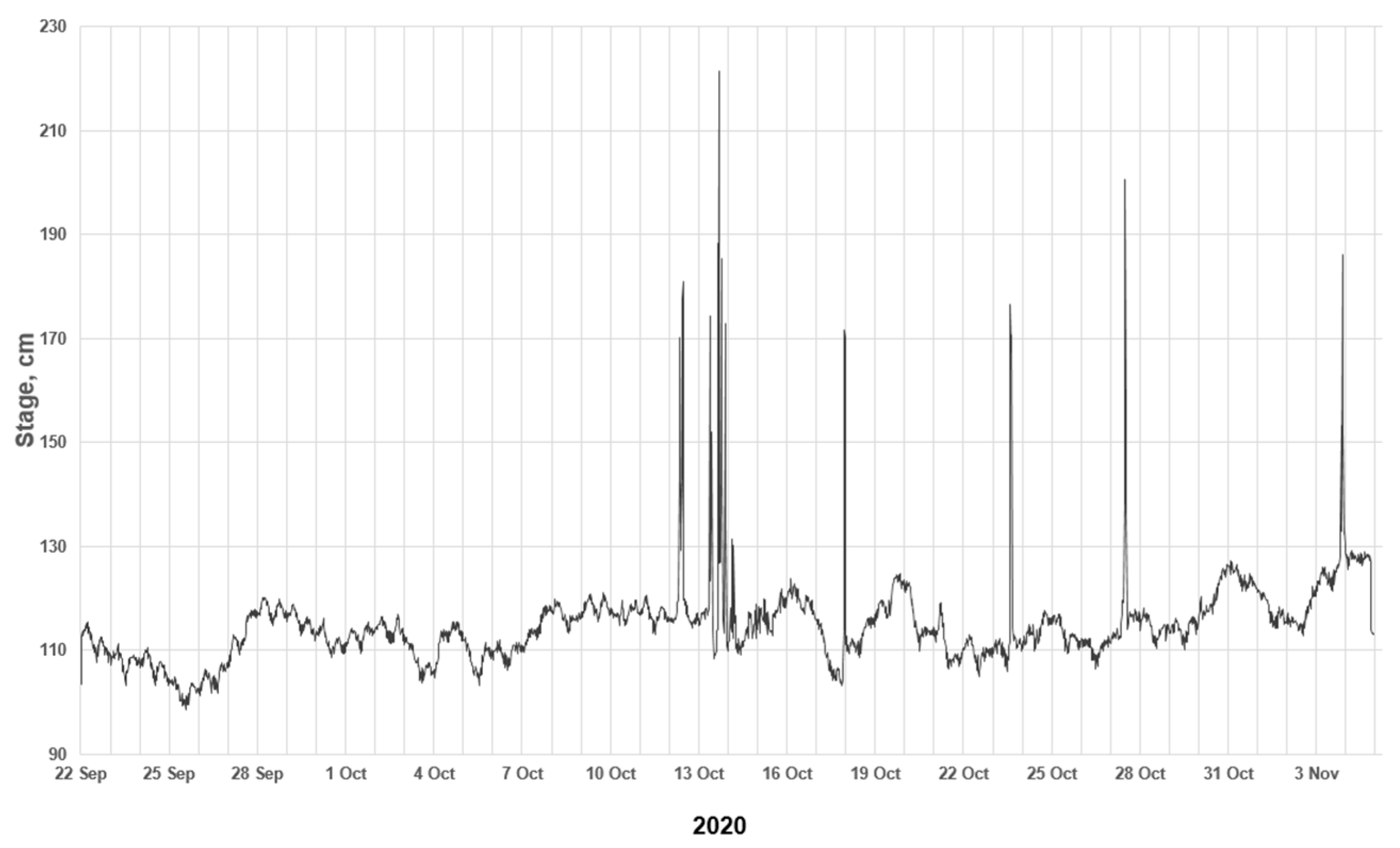
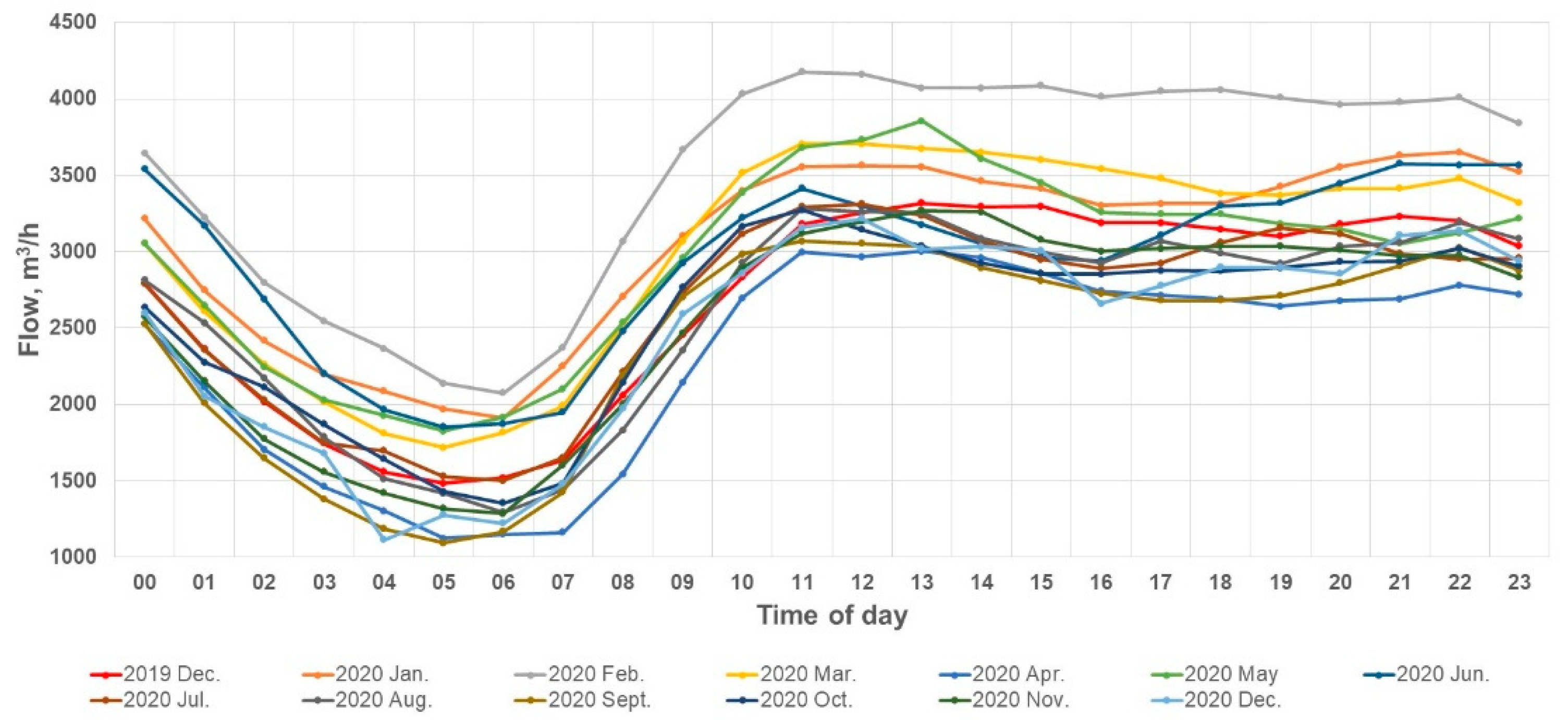
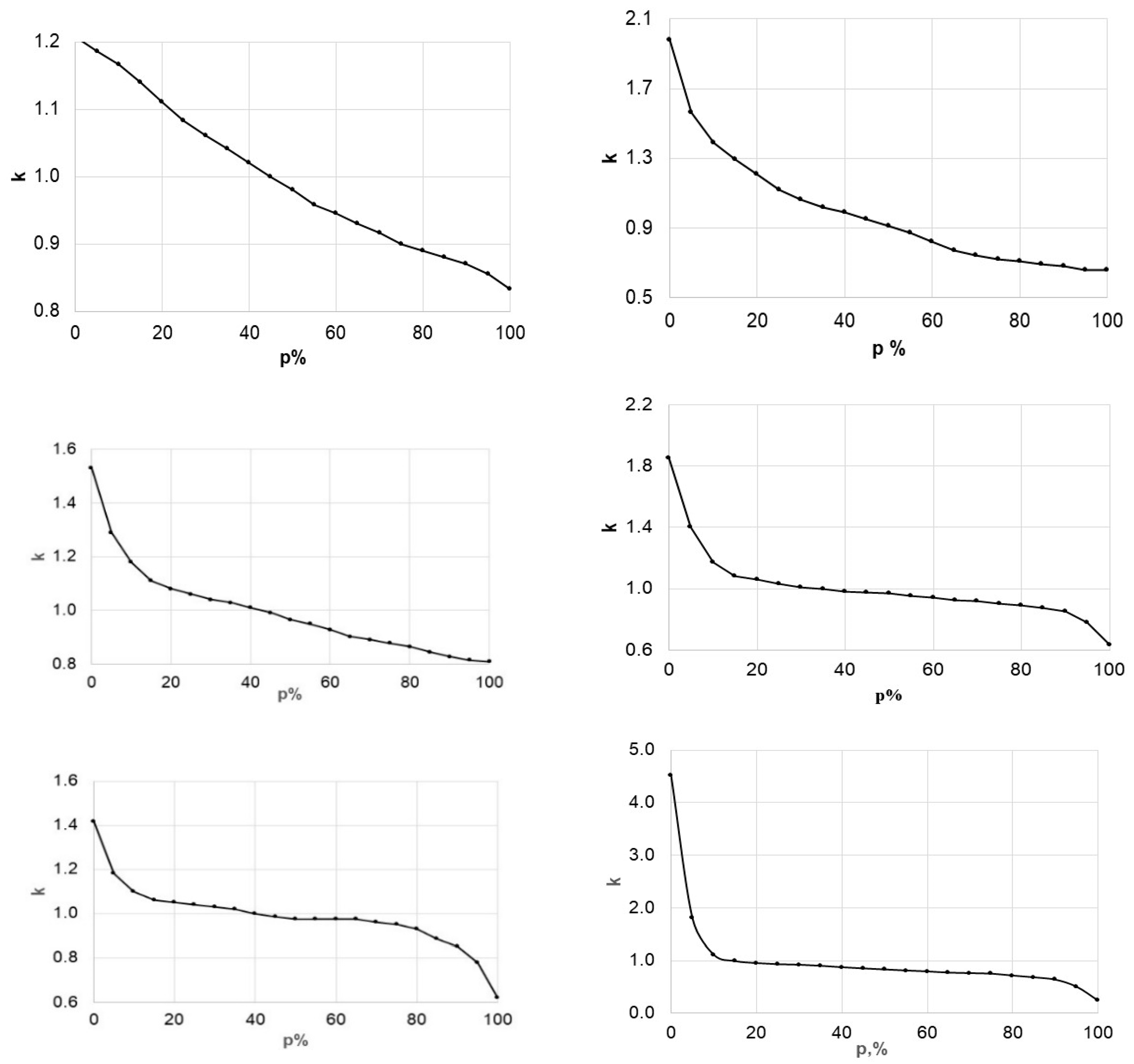
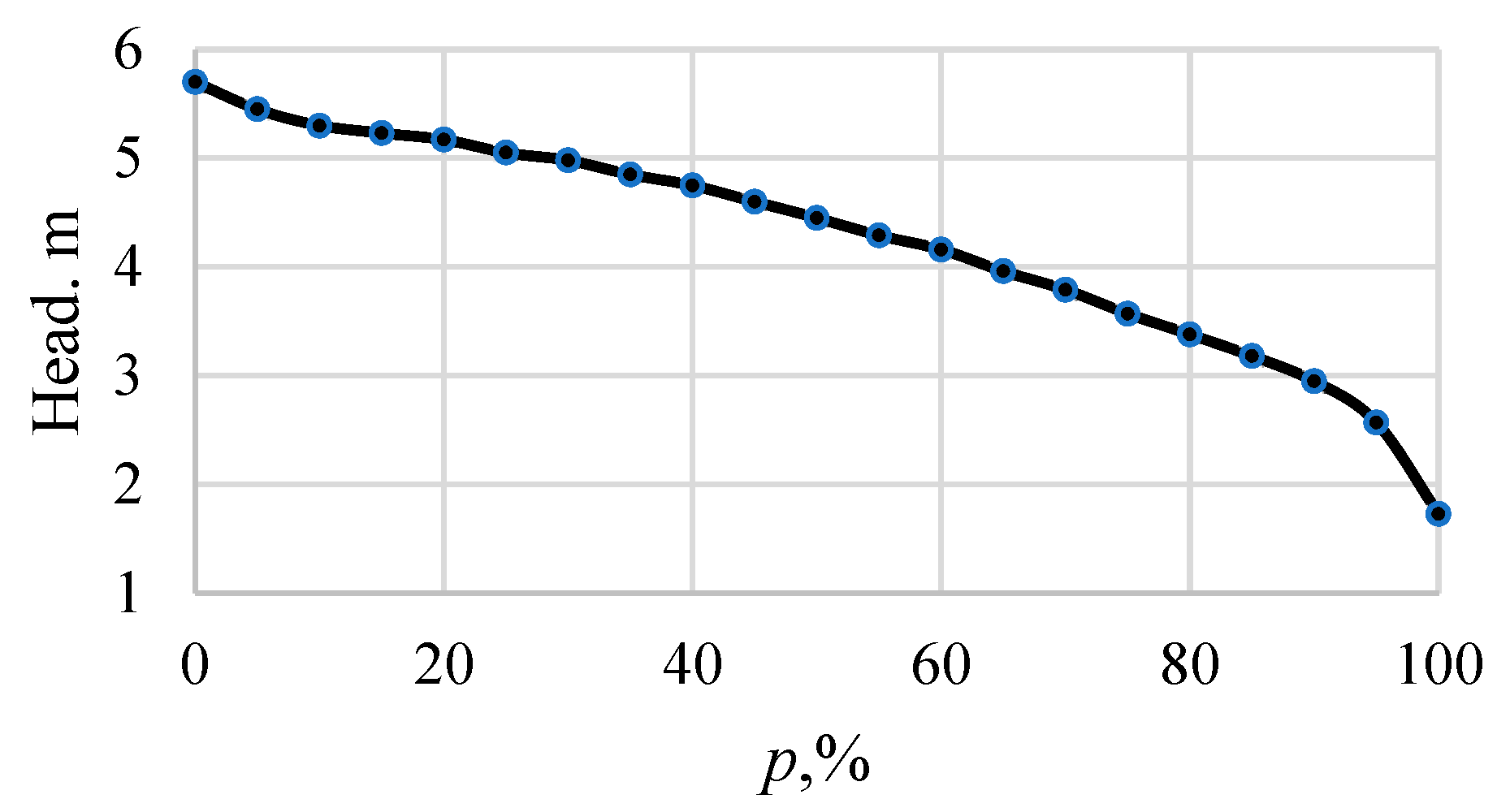

| Turbine | PaT | |
|---|---|---|
| Advantages | Well-documented, accurate design | Cost-efficient |
| Best efficiency | Widely available | |
| Wide range of control | Standardized, simple design product, short delivery, and low maintenance and repair costs | |
| Disadvantages | Expensive | Not as well-documented as turbines, limited availability of turbine operation curves 1 |
| Limited local suppliers | Lower efficiency 1 | |
| Complex design may be required | No variable guide vanes for varying flow |
| # | Name | ID Label | Population Equivalent (PE) | Service Area (km2) | Location 1 | Head (m) | Flow (m3/s) | Outlet |
|---|---|---|---|---|---|---|---|---|
| 1. | Kaunas (Jonavos street) | K1 | 104,300 | 25.3 | U/S | 35.0 | 0.3 | Sewage network |
| 2. | Kaunas (Raudondvario Street) | K2 | 36,800 | 16.4 | U/S | 27.4 | 0.18 | Sewage network |
| 3. | Kaunas (Pypliai) | K3 | 305,500 | 137.0 | D/S | 4.0 | 1.2 | The Nemunas River |
| 4. | Vilnius (WWTP-1) | V1 | 569,500 | 356.0 | D/S | 2 | 1.5 | Outlet collector |
| 5. | Vilnius (WWTP-2) | V2 | 569,500 | 356.0 | 2.9 | 1.5 | The Neris River | |
| 6. | Vilnius (Prusu Street) | V3 | 35,000 | 18.2 | - | 61.1 | 0.11 | Network |
| 7. | Alytus (WWTP-1) | A1 | 49,900 | 39.4 | D/S | 15.0 | 0.11 | Outlet collector |
| 8. | Alytus (WWTP-2) | A2 | 49,900 | 39.4 | 10 | 0.11 | The Nemunas River |
| # | Criterion | Unit of Measure | Direction | Weight (%) | Group and Weight | Alternatives (Projects) | ||||||||
|---|---|---|---|---|---|---|---|---|---|---|---|---|---|---|
| K1 | K2 | K3 | V1 | V2 | V3 | A1 | A2 | |||||||
| 1. | Layout | Score: [1, 2] | Max | 5.88 | TEC | 58.81 | 1 | 1 | 2 | 2 | 2 | 2 | 2 | 2 |
| 2. | Turbine type | Score: [1, 3] | Max | 5.88 | TEC | 2 | 2 | 3 | 3 | 3 | 2 | 2 | 2 | |
| 3. | Design flow | m3/s | Max | 5.88 | TEC | 0.36 | 0.14 | 1.00 | 1.80 | 1.80 | 0.17 | 0.17 | 0.17 | |
| 4. | Gross head | m | Max | 5.88 | TEC | 35 | 27 | 4 | 2 | 2.9 | 53 | 15.5 | 10 | |
| 5. | Substation | Score: [0, 1] | Max | 5.88 | TEC | 0 | 0 | 0 | 1 | 1 | 0 | 1 | 1 | |
| 6. | Transmission line | km | Min | 5.88 | TEC | 0.05 | 0.05 | 0.1 | 0.05 | 0.05 | 0.05 | 0 | 0.4 | |
| 7. | Power capacity | kW | Max | 5.88 | TEC | 98 | 29 | 28 | 20 | 34 | 73 | 20 | 13 | |
| 8. | Capacity factor | % | Max | 5.88 | TEC | 43 | 40 | 76 | 65 | 64 | 73 | 39 | 38 | |
| 9. | Tailwater effect | % | Min | 5.89 | TEC | 0 | 0 | 25 | 0 | 20 | 0 | 0 | 25 | |
| 10. | FDC type | Parameter | Max | 5.89 | TEC | 0.47 | 0.42 | 0.56 | 0.6 | 0.6 | 0.57 | 0.62 | 0.62 | |
| 11. | Total initial costs | k€ | Min | 5.88 | Econ | 29.42 | 101.1 | 61.7 | 76.3 | 50.8 | 80.9 | 47.3 | 18.7 | 14.0 |
| 12. | Electricity generated | MWh | Max | 5.88 | Econ | 367 | 102 | 185 | 111 | 189 | 331 | 69 | 43 | |
| 13. | Simple payback | yr | Min | 5.89 | Econ | 4.3 | 15.5 | 5.5 | 7.3 | 5.8 | 1.6 | 4.4 | 6.7 | |
| 14. | O&M costs | k€ | Min | 5.88 | Econ | 13.5 | 6.2 | 4.6 | 4.2 | 4.9 | 3.8 | 2.6 | 2.6 | |
| 15. | Electricity revenue | k€ | Max | 5.89 | Econ | 36.7 | 10.2 | 18.5 | 11.1 | 18.9 | 33.1 | 6.9 | 4.3 | |
| 16. | GHG reduction | tCO2/MWh | Max | 5.88 | ENV | 11.77 | 99 | 28 | 50 | 30 | 51 | 89 | 19 | 12 |
| 17. | Use of electricity | Score [1, 2] | Max | 5.89 | ENV | 1 | 1 | 1 | 2 | 2 | 1 | 2 | 2 | |
| Total (%) | 100 | 100 | ||||||||||||
| Name | Brief Description |
TEC
| 1. Priority should be assigned to the hydro turbine downstream of the WWTP (clean water); turbine placement upstream will require extra O&M costs (trash rack cleaning). 2. It is recommended to avoid Archimedean screw turbines because of their excessive superstructure and visual pollution, especially in urban areas. 3,4,7,8. Design flow, gross head power capacity, and capacity factor must be as high as possible. 5. Presence of any substation nearby hydro installation. 6. Distance to the electric distribution grid or the point of use of power must be as short as possible. 7,8. Must be maximized. 9. Range of water-level fluctuations in receiving water body should be minimal, i.e., to avoid any reduction in the available gross head during times of high flows in the outlet. 10. A flat-sloped FDC resulting in a high j value is desirable for any hydro scheme. |
ECO
| 11,13,14. Total initial costs, payback period, and O&M costs must be as low as possible. 12,15. The amount of electricity generated and the revenue must be maximized; priority should be assigned to local use of electricity generation for wastewater treatment, not to the grid. |
ENV
| 16. GHG reduction is to be maximized. 17. The best way is to use the produced power directly on-site at the plants. |
| # | R-Squared | Observations | Standard Error | Intercept | X-Variable | F | Significance F | t-Stat | p-Value |
|---|---|---|---|---|---|---|---|---|---|
| 1. | 0.88 | 56 | 0.023 | 0.0032 | 0.0032 | 378.2 | ca. 0 | 19.45 | ca. 0 |
| 2. | 0.97 | 56 | 0.035 | −0.0042 | 2 × 10−6 | 1673.8 | ca. 0 | 40.91 | ca. 0 |
| 3. | 0.62 | 52 | 0.018 | 0.070 | 0.0013 | 79.5 | ca. 0 | 8.91 | ca. 0 |
| 4. | 0.79 | 52 | 0.013 | 0.0054 | 1.51 × 10−6 | 192.0 | ca. 0 | 13.85 | ca. 0 |
| Turbine Type | Net Head (m) | Flow (m3/s) | Power (kW) | Comments | Reference | |
|---|---|---|---|---|---|---|
| 1. | Amjet ATS | 1.5–12.8 | 0.2–26.0 | 3–2500 | A range of series is available 1 | [62] |
| 2. | StreamDiver | 2.0–8.0 | 2.0–12.0 | 50–1450 | There are at least 7 modules | [63] |
| 3. | Turbiwatt | 1.2–8.0 | 0.1–3.6 | 3–120 | Three (3) available modules/series | [64] |
| 4. | Flygt | 2.5–20.0 | 0.7–10.0 | 40–850 | Six (6) available modules/series | [66] |
| 5. | Hydromatrix | 2.0–25.0 | 5.0–13.0 | 200–2200 | Very large flow | [65] |
| Year | Developer | Operating System | Applicable Countries | Application | Accessibility | Features | |||||||||
|---|---|---|---|---|---|---|---|---|---|---|---|---|---|---|---|
| Units | Energy | Hydrology | Hydraulics | Turbines | Costing | Economic | GHG | Design Level | |||||||
| RETScreen [38] | 1998 | Canada | Software | International | Conventional HP | Open 1 | SI | x | FDC | x | PaT not included | x | x | x | Feasibility and preliminary design |
| ICHPST [33] | 2013 | Alden, US | MS Excel | USA | WSW | Open | I 2 | x | FDC | - | Mostly all types, including PaT | x | x | x | Screening |
| BCAT [12] | 2019 | Stantec, US | MS Excel | USA | WSW | Open | I 2 | x | Design flow | - | Mostly all types, including PaT | x | x | x | Screening |
| Alternatives | Index | ||||||||||||
|---|---|---|---|---|---|---|---|---|---|---|---|---|---|
| ci Concordance Dominance Index | di.SD Simple Discordance Index | di.WD Weighted Discordance Index | di.AD Aggregate Discordance Index | di.AWD Weighted Aggregate Discordance Index | GSi Global Synthetic Index | ||||||||
| A. Basic scenario: Criteria weights are equal, and group weights are different (ECO—29.42%, TEC—58.81%, ENV—11.77%) | |||||||||||||
| a | K1 | 6 | 0.001 | 5 | 0.108 | 5 | 0.099 | 6 | 0.732 | 6 | 0.730 | 6 | −0.728 |
| b | K2 | 8 | −1.530 | 7 | 0.301 | 7 | 0.299 | 8 | 1.931 | 8 | 1.929 | 8 | −3.460 |
| c | K3 | 5 | 0.059 | 4 | 0.0 | 4 | −0.007 | 4 | −0.444 | 4 | −0.444 | 5 | 0.503 |
| d | V1 | 2 | 0.764 | 1 | −1.768 | 1 | −1.758 | 1 | −1.514 | 1 | −1.511 | 1 | 2.275 |
| e | V2 | 4 | 0.353 | 6 | 0.127 | 6 | 0.133 | 3 | −0.855 | 3 | −0.853 | 3 | 1.206 |
| f | V3 | 1 | 1.060 | 2 | −0.409 | 2 | −0.417 | 2 | −1.186 | 2 | −1.186 | 2 | 2.246 |
| g | A1 | 3 | 0.529 | 3 | −0.086 | 3 | −0.081 | 5 | −0.148 | 5 | −0.147 | 4 | 0.676 |
| h | A2 | 7 | −1.236 | 8 | 1.727 | 8 | 1.729 | 7 | 1.484 | 7 | 1.482 | 7 | −2.718 |
| B. High economic scenario: Criteria weights are not equal, and group weights are different (ECO—49.39%, TEC—42.18%, ENV—8.43%) | |||||||||||||
| a | K1 | 2 | 1.076 | 5 | 0.108 | 1 | −1.720 | 6 | 0.732 | 3 | −0.345 | 2 | 1.421 |
| b | K2 | 7 | −1.606 | 7 | 0.301 | 8 | 2.371 | 8 | 1.931 | 8 | 1.276 | 8 | −2.882 |
| c | K3 | 5 | 0.098 | 4 | 0.0 | 6 | 0.633 | 4 | −0.444 | 5 | −0.120 | 5 | 0.219 |
| d | V1 | 4 | 0.151 | 1 | −1.768 | 5 | 0.198 | 1 | −1.514 | 2 | −0.439 | 4 | 0.591 |
| e | V2 | 3 | 0.423 | 6 | 0.127 | 7 | 0.812 | 3 | −0.855 | 4 | −0.287 | 3 | 0.710 |
| f | V3 | 1 | 1.722 | 2 | −0.409 | 2 | −1.560 | 2 | −1.186 | 1 | −1.039 | 1 | 2.761 |
| g | A1 | 6 | −0.073 | 3 | −0.086 | 3 | −0.773 | 5 | −0.148 | 6 | 0.072 | 6 | −0.145 |
| h | A2 | 8 | −1.792 | 8 | 1.727 | 4 | 0.039 | 7 | 1.484 | 7 | 0.882 | 7 | −2.674 |
Publisher’s Note: MDPI stays neutral with regard to jurisdictional claims in published maps and institutional affiliations. |
© 2022 by the authors. Licensee MDPI, Basel, Switzerland. This article is an open access article distributed under the terms and conditions of the Creative Commons Attribution (CC BY) license (https://creativecommons.org/licenses/by/4.0/).
Share and Cite
Punys, P.; Jurevičius, L. Assessment of Hydropower Potential in Wastewater Systems and Application in a Lowland Country, Lithuania. Energies 2022, 15, 5173. https://doi.org/10.3390/en15145173
Punys P, Jurevičius L. Assessment of Hydropower Potential in Wastewater Systems and Application in a Lowland Country, Lithuania. Energies. 2022; 15(14):5173. https://doi.org/10.3390/en15145173
Chicago/Turabian StylePunys, Petras, and Linas Jurevičius. 2022. "Assessment of Hydropower Potential in Wastewater Systems and Application in a Lowland Country, Lithuania" Energies 15, no. 14: 5173. https://doi.org/10.3390/en15145173
APA StylePunys, P., & Jurevičius, L. (2022). Assessment of Hydropower Potential in Wastewater Systems and Application in a Lowland Country, Lithuania. Energies, 15(14), 5173. https://doi.org/10.3390/en15145173







